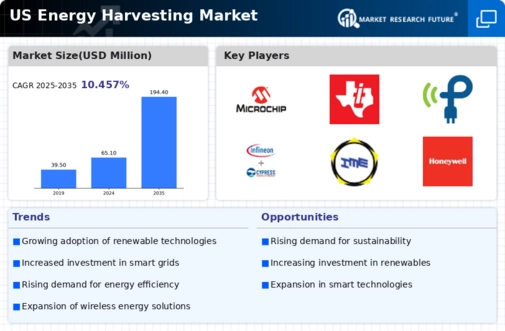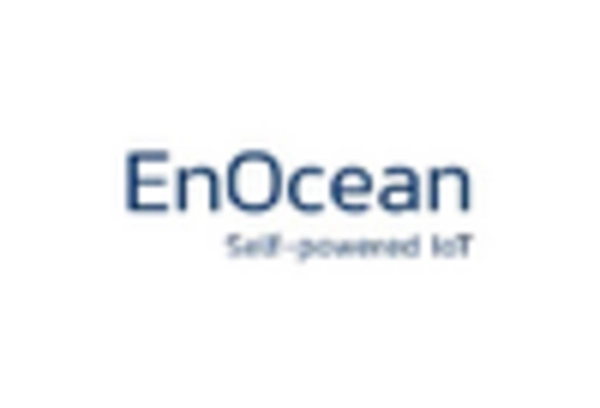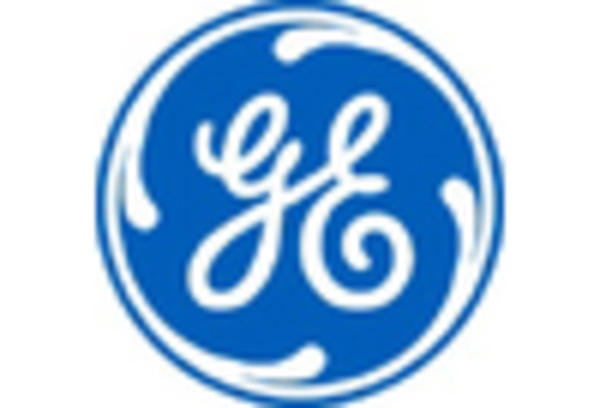Government Initiatives and Funding
Government initiatives and funding are crucial drivers of the energy harvesting market. In the US, various federal and state programs are promoting research and development in renewable energy technologies. These initiatives often provide financial support for projects that focus on energy efficiency and sustainability. For example, the Department of Energy has allocated substantial funds to support innovative energy harvesting solutions. This backing not only stimulates technological advancements but also encourages private sector investment in the energy harvesting market. As a result, the market is likely to see increased activity, with projections indicating a potential market size of $1.8 billion by 2028, driven by government support and collaboration with private enterprises.
Integration of IoT and Smart Devices
The integration of Internet of Things (IoT) technologies is significantly influencing the energy harvesting market. As smart devices proliferate, the demand for energy-efficient solutions that can power these devices without reliance on traditional batteries is growing. The energy harvesting market is adapting to this trend by developing solutions that harness ambient energy from the environment, such as solar, thermal, and kinetic energy. This shift is expected to drive market growth, with estimates suggesting a market value of $1.6 billion by 2025. The increasing adoption of smart home technologies and wearable devices further underscores the potential for energy harvesting solutions to provide sustainable power sources, thereby enhancing the functionality and longevity of these devices.
Growing Focus on Off-Grid Applications
The energy harvesting market is witnessing a growing focus on off-grid applications, particularly in remote and rural areas. As the demand for energy independence increases, there is a rising interest in solutions that can provide power without relying on traditional grid infrastructure. This trend is particularly relevant in the US, where many regions still lack reliable access to electricity. The energy harvesting market is responding by developing technologies that can efficiently capture and convert ambient energy into usable power. This shift is projected to contribute to a market growth rate of approximately 10% annually, with a potential market size of $1.4 billion by 2026. The emphasis on off-grid solutions not only addresses energy accessibility but also aligns with broader sustainability goals.
Rising Demand for Sustainable Solutions
The energy harvesting market is experiencing a notable surge in demand for sustainable energy solutions. As environmental concerns escalate, industries are increasingly seeking alternatives to traditional energy sources. This shift is driven by regulatory pressures and consumer preferences for eco-friendly products. In the US, the energy harvesting market is projected to reach approximately $1.5 billion by 2026, reflecting a compound annual growth rate (CAGR) of around 12%. This growth is indicative of a broader trend towards sustainability, where businesses are investing in energy harvesting technologies to reduce their carbon footprint and enhance their corporate social responsibility initiatives. The energy harvesting market is thus positioned to benefit from this growing emphasis on sustainability, as companies strive to align their operations with environmental goals.
Technological Advancements in Energy Harvesting
Technological innovations are playing a pivotal role in shaping the energy harvesting market. Recent advancements in materials science and engineering have led to the development of more efficient energy harvesting devices. For instance, piezoelectric materials and thermoelectric generators are becoming increasingly sophisticated, enabling higher energy conversion efficiencies. The energy harvesting market is witnessing a shift towards miniaturization and integration of these technologies into consumer electronics and industrial applications. As a result, the market is expected to grow significantly, with estimates suggesting a value of $2 billion by 2027. This growth is fueled by the need for reliable, low-maintenance energy sources in various sectors, including healthcare, automotive, and smart cities.

















Leave a Comment